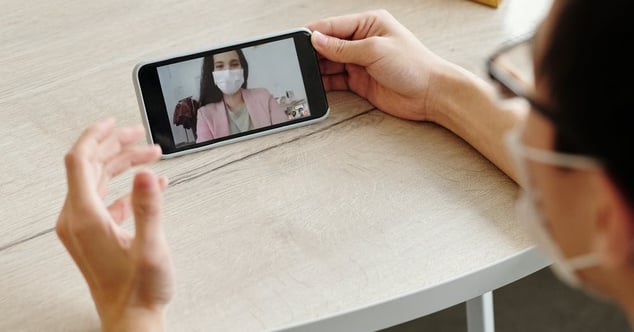How WiFi SPARK’s Patient Engagement Platform is Evolving to Increase Patient Happiness
11 minute read

There are many reasons why hospitals require patient engagement platforms.
Patient engagement platforms help to streamline operations and cut costs, but their main aim is as their name suggests, to increase engagement across the patient spectrum, meeting entertainment expectations, facilitating connections, reducing readmissions and empowering individuals with accessible, accurate health information.
As an established patient engagement platform provider, we continually review how WiFi SPARK meets its aims and update our offering to better serve healthcare providers and their patients and staff across the UK.
Here’s a list of our latest updates and how they're evolving our patient engagement platform, SPARK® Media, to increase patient happiness—at a time when individuals need it most.
- Facilitating Connections for All Families
- Making Meal Ordering Even Easier
- Enhancing TV Entertainment Options
- Updating Films (Even Before Netflix)
- Giving the Gift of Games
- Better Support Patients via the Platform
- In-Depth Analytics and Usage Stats
1. Facilitating Connections for All Families

We’ve long known the critical role that families play in patient experience.
Relatives offer an entirely personal point of view that is often one of the only constants before, during and after professional care.
Published in the Patient Experience Journal, personal trainer, author and now patient experience expert, Brian Boyle writes: “The loved ones of a patient might not have a medical license or healthcare background, but their voice and presence matters in the hospital room.”
The Problem
During COVID, family visitation has been strictly limited, meaning other methods of patient engagement have become even more important.
Speaking to Patient magazine, Age UK’s director, Caroline Abrahams addresses this, saying: “Not being able to visit a loved one is likely to be distressing so finding different ways to stay in touch can help [...] even if your loved one can’t communicate with you, they may find hearing your voice a comfort.”
The Solution
The ability to instant message, speak on the phone and video call has become the next best thing to seeing your family in the flesh, which is why we’ve spent time developing simplified, all-inclusive video calling to facilitate connections for all types of families, no matter a patient’s needs or capabilities.
WiFi SPARK’s video calling functions now cater to those who aren’t as tech-savvy as its service is available without needing to log in to an account. The patient clicks the app, enters the recipient's phone number and waits for them to accept their invite and join the call.
2. Making Meal Ordering Even Easier
As well as having a significant effect on healthcare operations and costs—in some cases, saving as much as £26K in a year—convenient, customised meal ordering also impacts patients—both emotionally and physically.
The Problem
In October 2020, the NHS began reviewing a new blueprint for better hospital food, admitting that there was room for improvement across the board including, upgrading hospital kitchens, introducing interactive menus, agreeing on national professional standards for NHS chefs and increasing the role of other professionals in overseeing food services as part of a patient’s recovery plan.
As part of this, digital menus and food ordering menus were discussed to “factor in a patient’s dietary and cultural requirements, and nutritional needs.” The switch to electronic menus is thought to “improve communication between dietitians and caterers, reduce food waste and provide patients with the right food for recovery.”
The Solution
Despite how elementary electronic meal ordering may sound, it clearly has both a short-term patient happiness benefit in allowing customers to control their daily meals as well as a long-term effect, giving them a shorter road to recovery. As such, the importance of efficient, electronic meal ordering is now being recognised nationwide with the NHS committing to digital menus by 2022.
WiFi SPARK is attempting to go one step further by fast-tracking this service. Electronic meal ordering is already available on our system, giving patients the opportunity to request meals closer to mealtimes and customise dishes to suit their dietary needs.
3. Enhancing TV Entertainment Options

Both day admissions and longer hospital stays are made better by the availability of varied, up-to-date entertainment options.
In a similar way that family members provide a source of comfort and familiarity to patients, TV gives individuals a home from home experience. When visiting hours are over or when quiet time is needed, TV programmes allow patients to indulge in some downtime and engage in well-needed entertainment escapism.
The Problem
Some people go as far as to say that TV is essential—especially for isolated patients. Yet, this apparent healthcare must-have still fails to impress individuals both in terms of its price and package.
For some time, healthcare entertainment has felt outdated and expensive when compared to the average household’s streaming services available today. From Netflix to Amazon Prime, hospital TV seems a world away from the on-demand and high-definition quality that we’re used to. Technology that doesn’t live up to our expectations can have the opposite effect of comforting and calming patients, accentuating the void between home and hospital.
The Solution
Recognising that the availability of entertainment needs to change, WiFi SPARK is updating its TV options to include live TV and catch up TV, free to access.
Mirroring our at-home entertainment habits, patients can now stay in the loop during their stay and feel less like they’re trapped in a different decade. Sport lovers can watch games as they happen. Reality TV watchers won’t wake up worried to see spoilers all over social media. Whatever their watching preferences, patients will be able to see their favourite shows, at any time of the day.
4. Updating Films (Even Before Netflix)
For the most immersive entertainment, patients often turn to film for an uninterrupted experience that lasts for a few hours, at the least.
Whether it’s a lighthearted movie that patients can dip in and out of to help distract and manage pain or a more serious flick to settle down to, movies can be transformative. In fact, the concept of Cinema Therapy has even been introduced in some NHS hospitals allowing patients to visit screenings and mimic the full-screen cinema experience.
The Problem
We know film is important but often, patients can be left unenthused about their options or only half bought-in to their watching experience as they settle for a title they’ve already seen on the silver screen.
Perhaps the only two places where watching a film is one of our only feasible options for entertainment is in a hospital or on a plane. And while in-flight entertainment has come on leaps and bounds, hospital entertainment is only just starting to follow suit.
The Solution
We’re shaking up healthcare’s access to the silver screen, offering pay-per-view blockbuster titles before they even land on leading streaming services like Netflix.
Patients can be truly engrossed in never seen before movies and pay less than the price of a cinema ticket to access them.
5. Giving the Gift of Games

A more interactive way to pass the time as a patient is by playing games, be it a classic such as a crossword or a more contemporary, themed puzzle.
Games allow patients to get involved, as opposed to always engaging in passive activities. This benefit extends to help those with dementia as experts suggest brain training and other activities keeps brains active as well as improve cognitive ability.
Although games don’t have the power to rewind a condition or change a patient’s circumstances, they can certainly make a hospital stay easier and contribute to someone’s quality of life. The NHS recommends online games and puzzles as a suitable activity specifically for patients with dementia, but more generally for every patient.
Another audience that benefits from games is younger patients. Children adapt to healthcare environments easier when playing games—a pastime that’s familiar to them and helps them to express emotion in a safe space. Gaming can even be linked to better pain perception, proving it helps with more than just everyday entertainment.
The Problem
Despite the long-lasting impact of games and the mental stimulation they provide, not many entertainment systems extend to anything more than the most basic logic and trivia libraries.
Only those with personal devices and the ability to afford and access independent games from an app store can engage in enough game activity to see real benefits during their stay. This shortcoming stops patients from accessing a truly helpful outlet to engage in on their own or as part of a team.
The Solution
Clearly, there needs to be better availability of interactive entertainment in healthcare for all patients, including specific audiences that benefit from play and brain training the most.
In response, we’re updating our entertainment offering to include a new games feature. This hub will allow users to choose from over 25 free puzzles. The main aim of this update is to increase patient happiness, although we hope it may also help anxious visitors to alleviate the stress of wait times and find talking points during difficult times.
6. Better Supporting Patients via the Platform
Patient engagement platforms are as much about education and emotional support as they are about entertainment—or at least they should be.
When trying to meet the goal of increasing patient happiness, it can be tempting to focus on “quick wins” such as an enhanced entertainment package. Yet, while appeasing patients and enhancing their time in hospital helps, true patient happiness and a long-term positive perception of patient experience come from much greater needs than the yearning to switch off and watch a show. In an ideal world, patient engagement platforms should do both, supporting a patient in their daily activities as well as in their long-term health journey.
The Problem
For patient engagement platforms to live up to their name and truly engage their users, their interface needs to be rethought and pivot to become more about the long-term picture.
According to The Official Journal of the Society for Academic Emergency Medicine, digital health platforms, by definition, should “help patients self-monitor; encourage behaviour change; improve comprehension of diagnoses and discharge plans; and permit dynamic interchanges between patients, their healthcare data, and clinicians.”
Suggested frameworks for evaluating patient engagement also state that providing educational information is a foundational strategy for activating a patient’s use of mobile applications. Yet, in most cases, these types of features either don’t exist or aren’t widely adopted by their audience.
The Solution
Perhaps the solution is in repackaging this type of support so that it encourages users to engage with it. From live chat to interactive health education, WiFi SPARK’s support area is nestled side by side with our most popular features and is offered in familiar, already adopted formats.
As well as the physical support from our team for using the service, other ‘support’ services are available as part of the solution. These range from Dementia support services and links to access to health and educational videos allowing patients to be clued up on their diagnosis, learn how to self-help and understand what might be involved after they’ve left the hospital.
Support feels anonymous, accessible and simple enough for anyone to use, helping to reduce readmission rates (estimated to cost the NHS £1.6B) and empower individuals to feel more in control of their care.
7. In-Depth Analytics and Usage Stats

Finally, patient engagement platforms should empower those who implement it, as well as those who use it. Although the benefits to healthcare providers seem less about the patient and more about the provider, they indirectly benefit patients by allowing IT to be improved depending on usage data.
Statistical software is imperative for the development of any app. Otherwise, how would providers be able to assess the effectiveness of the platform and its value to its audience?
The Problem
Many patient engagement platforms are still primitive as up until a few years ago many hospitals were still relying on PHRs (Public Health Records) to interact with patients. For this reason, many patient engagement systems are still finding their feet in terms of development and are in the process of rolling out the first generation of an app.
Understandably, new technologies—patient engagement platforms included—experience teething problems and glitches before they satisfy the needs of their customers.
But, unfortunately, in healthcare, there isn’t much time to wait.
With more patients in hospital than ever before, patient engagement and patient happiness need to be at the top of the agenda, not to mention be made available on a mass scale. Obviously, admissions have been affected by coronavirus but non-covid admissions still remain high, only showing signs of a slight decrease year on year.
What’s more, hospital’s workloads are now backed up. For example, there are long waits for specialist treatment, with 13-fold waiting more than a year for treatment in 2021. This pressure can also be seen in emergency department waits that rarely reach their four-hour target.
The Solution
All of this promises patient morale, engagement and happiness will be affected with significant interruption to treatment.
As an established patient engagement platform, WiFi SPARK offers a tried-and-tested solution with in-built analytics, so you can review how, when and where patients are using which apps. You can also integrate with patient surveys for more feedback.
We go one step further than providing healthcare facilities and hospitals with a platform for engagement—we help you to check if patient engagement is working in practice. In turn, we empower you to make adjustments as needed, whether it’s related to how patients interact with the media or how often they’re using the support services.
About the author
Rebecca O'Donovan
Rebecca is the Marketing Director. She's worked for SPARK TSL since 2012. She is responsible for high level marketing strategy focusing on lead generation and aiding the vision of the business; to ensure that no patient has to pay for entertainment.
More articles by the author
Related articles
 Company News
Company News
Upgrading Your Patient Entertainment and Engagement System
Hospitals are often bustling with activity and this can result in patients and visitors having to endure long ...
 Patient Experience
Patient Experience
Patient Experience vs Patient Satisfaction: The Difference
Patient experience and patient satisfaction are two terms that are both important in the healthcare industry. ...
 Patient Experience
Patient Experience
What It's Like Being a Patient in Hospital
WiFi SPARK is here for patients in hospital. I find out more about their needs and how our services can help ...


